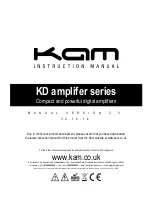
©2001 Hamtronics, Inc.; Hilton NY; USA. All rights reserved. Hamtronics is a registered trademark. Revised: 7/8/03
- Page 1 -
DESCRIPTION.
The LNK-( ) series of low-noise pre-
amps employs one of the new genera-
tion diode-protected dual-gate MOS
FET devices which are designed ex-
clusively for use in the vhf & uhf
bands. The 1 dB compression point
for these preamps is approximately
+5dBm. Surface mount technology is
used to obtain minimum noise figure
and best stability.
The preamp is connected in series
between the antenna and the receiver
to effectively lower the noise figure of
the receiver front end, allowing weaker
signals to be received. The LNK series
was designed for operation in 50 ohm
systems; however, they will operate
satisfactorily on 75 ohms as well.
INSTALLATION.
MOUNTING.
The preamp can be
mounted to any flat surface with
screws through the two mounting
holes inside the chassis, as shown
below. When replacing the cover
screws, be careful not to make them
so tight that the cover is bowed. It is
not necessary that the cover screws be
very tight. It also is not necessary to
make the mounting screws overly
tight. Because of the thickness of the
screw heads under the chassis, if you
do want to make the mounting screws
really tight, you should add flat wash-
ers under the chassis on the mount-
ing screws.
For best results, in a receiving sys-
tem when antenna is not also used for
transmit, preamp can be mounted
right at the antenna. Install the pre-
amp on a flat aluminum panel U-
bolted to the antenna mast. Then,
caulk around base of preamp and
around B+ and coax cables to weath-
erproof unit. Silicone sealant is good
for this purpose.
RF CONNECTIONS.
Antenna and
receiver connections are made with
BNC plugs to the input and output
jacks on the preamp. The RF INPUT
must be connected to the antenna,
and the RF OUTPUT must be con-
nected to the receiver input.
CAUTION:
The preamp cannot be
used on a transceiver unless you have
a way to connect it only in the receive
rf path.
Use good quality low-loss coax to
maintain low noise operation. Re-
member that any loss in coax from
antenna cannot be made up later in
the preamp; it adds directly to system
noise figure.
POWER CONNECTIONS.
Power
for the unit must be fi10 to 15
Vdc. Current drain is about 10 mA.
Connect positive supply to wire ex-
tending from case. If you need a
longer wire, you can either splice onto
the existing wire or replace it by sol-
dering a long wire to the power pad on
the pc board inside the unit. Most
times, the power supply ground con-
nection can be made through the coax
shield. Otherwise, connect a separate
power supply ground wire to one
mounting screw at the chassis.
If you have a receiver which feeds
+12Vdc up the antenna cable to a
preamp, rf choke L3 can be added to
the LNK-( ) Preamp to allow power to
be taken from the coax. (This choke
is not supplied, but we sell a PF-1
Power Feed Kit, which has parts you
can use at both ends of the cable.)
Note that such an arrangement can
affect the rf performance of a preamp;
so we recommend you use a separate
piece of hookup wire to provide power
whenever possible.
/
/
/
/
CAUTION:
Solid state amplifiers
can be damaged by large voltage tran-
sients and reverse polarity. Although
protection is provided in the preamp,
avoid such conditions as a matter of
principle. Special care should be
taken to install reverse transient ab-
sorbing diodes across any inductive
devices, such as relays. If the preamp
is connected to an antenna used for
transmit as well as receive, be sure
that the unit is connected only in the
receive path and that the coax relay
has sufficient isolation to avoid cou-
pling large amounts of rf to the pre-
HAMTRONICS® LNK-( ) RECEIVER PREAMP: INSTALLATION,
OPERATION, & MAINTENANCE
MODEL
TUNES RANGE
TYPICAL
NOISE FIG.
GAIN
MIN. 3DB
BANDWIDTH
LNK-28
24-37 MHz
0.6 dB
26 dB
±2 MHz
LNK-50
35-63 MHz
0.6 dB
24 dB
±3 MHz
LNK-100
88-108 MHz
0.6 dB
22 dB
±5 MHz
LNK-120
108-140 MHz
0.6dB
22 dB
±4 MHz
LNK-137
130-160 MHz
0.6 dB
18 dB
±4 MHz
LNK-146
130-160 MHz
0.6 dB
18 dB
±4 MHz
LNK-166
150-180 MHz
0.6 dB
16 dB
±5 MHz
LNK-220
195-240 MHz
0.7 dB
18 dB
±5 MHz
LNK-400
360-440 MHz
0.8 dB
19 dB
±5 MHz
LNK-450
400-470 MHz
0.8 dB
18 dB
±5 MHz
Note: Units are aligned to center of band.
WHEN DOES A PREAMP HELP?
It is tempting to hope that a pre-
amp can make any receiver more sen-
sitive in any situation. It is important
to understand what happens when you
add a preamp before a receiver.
A preamp can help overcome a defi-
ciency in receiver sensitivity
only
if
the noise figure is poor, either due to
the design or because a lossy filter
or cable adds to the noise figure.
For instance, a preamp up at the an-
tenna can overcome the effects of
coax cable loss.
However, adding gain in the front
end raises all signal levels; so, in ef-
fect, every dB of gain added over-
rides 1 dB of i-f selectivity or
dynamic range. Therefore, adding a
preamp can result in intermod or de-
sense. The only way to know is to try
it!




















